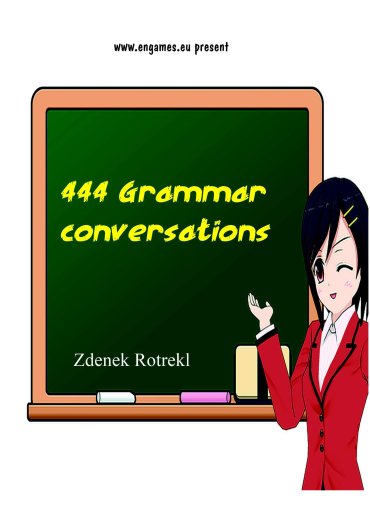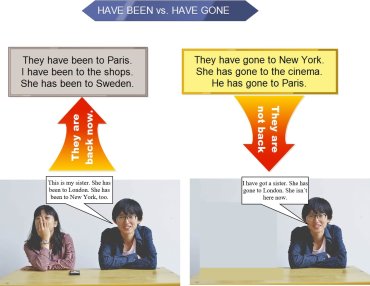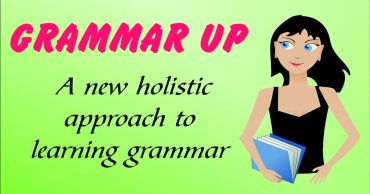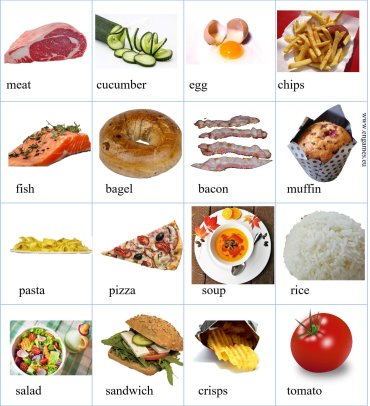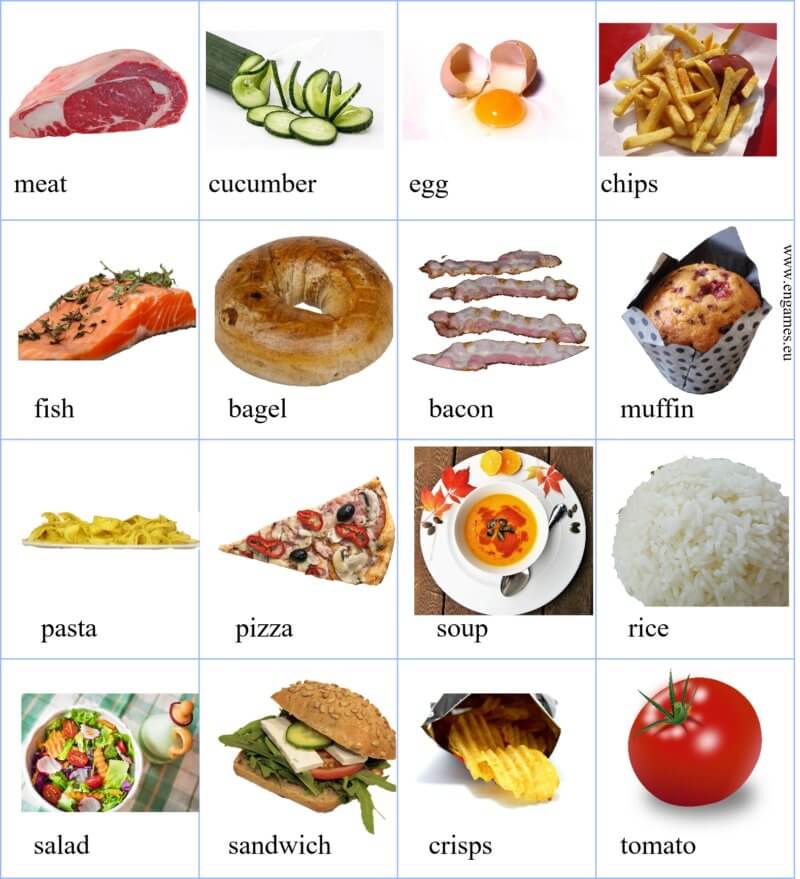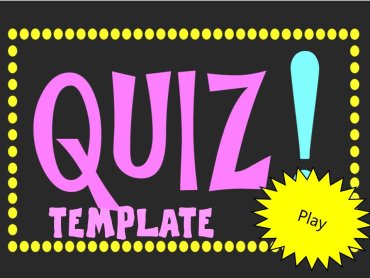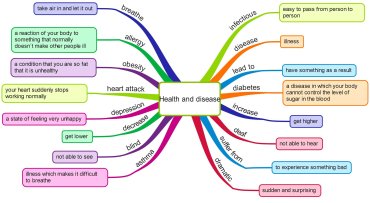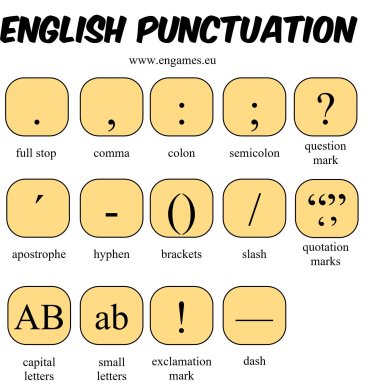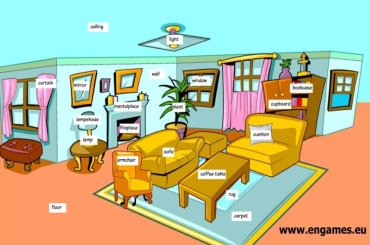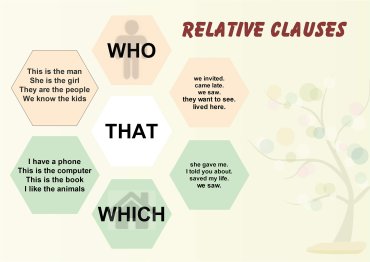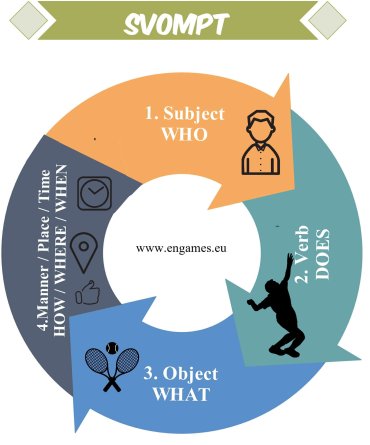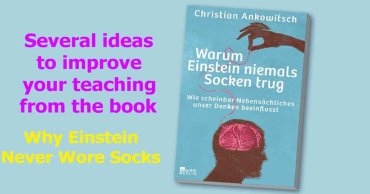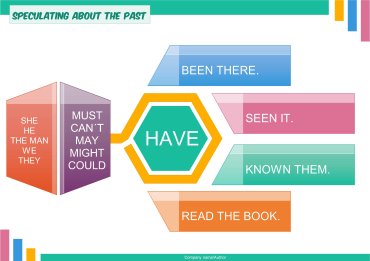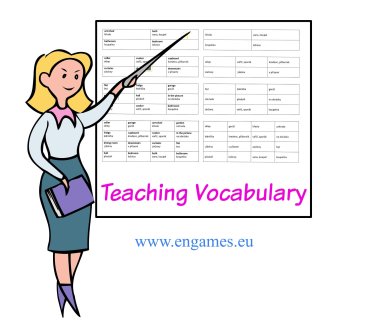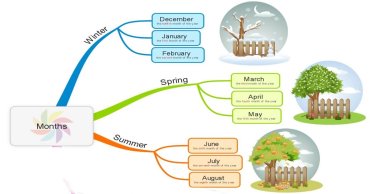Games to help students learn English.
This time I offer a free download of my book 444 Grammar Conversations. As the title suggests, this book contains nearly 500 speaking clues to practise grammar in conversations.
To learn a grammar point, students need to understand it and then exercise it in speaking. That is why many teachers constantly search for some speaking activities to practise a given grammar point.
444 Grammar Conversations – How to use this book
Go to the appropriate section and copy the cues there. You can adapt the questions for the use in your classroom.
I use the cues in the following ways:
- ) The simplest one is, that I print the questions for everyone and students work in pairs and read the questions and answer them.
- ) Print the questions just once for each pair and give the copy to one student in the pair. The student with the handout asks the questions and the other answers them.
- ) Print one copy for each pair and cut it in half. Each student asks their questions and answers the questions their partner asks.
- ) My favorite activity is called Clock speaking. Divide the questions into several sections and write a time instead of a number to each section. Tell the students to find a different partner for each section. Then say what time it is and students have to work with the partner they have arranged. They ask the questions and answer them.
- ) Print the questions for every student and ask them to choose 5 questions they like best. Then the students work in pairs and ask and answer the questions they have selected.
I hope you like this book. If you do, please like our site and share the book.
You can download our book Grammar Up here for free. This book features a completely new way of teaching grammar so it is worth checking out.
Coming next
Next week we hope to publish a post on forming questions in the past tense. As a preview you can listen to the rap song which we created for this post.
The difference between the words BEEN and GONE is a nice example of how closely grammar and vocabulary are connected. Usually, when you use a grammar rule wrongly, the meaning does not change. However, in this case, the wrong usage changes the meaning of the sentence completely.
ADVERT:
[showmyads]
To help you explain this grammar to your students, in this post there is an infographic and an interactive video. The infographic tries to explain the grammar in a simple visual way. The video offers the explanation and there are two exercises. Your students can practise the grammar, too, as there are always gaps when the students can say their answers to the questions.
BEEN or GONE – infographic
The following infographic explains the usage of the words BEEN and GONE in the present perfect tense.

As you can see in the infographic, the form HAVE BEEN is used when we want to say that the person is back at home, but they were somewhere before. We use the form HAVE GONE if the person went away and has not returned yet.
BEEN or GONE – video
To make the explanation clearer and more interesting, I created the following video.
The video is interactive. It has been recorded in such a way, that your students can answer most of the tasks themselves. When the speaker asks a question, there is always a gap that is seven seconds long. In this pause, students can answer the questions. They hear the correct answer then. This is a great feedback for them as they can see whether they answered correctly or not.
You can learn more about the present perfect tense at British Council website.
Another useful website explaining the difference between the words BEEN and GONE is the BBC learning English website.
In this post, I would like to give away my book called GRAMMAR UP. This book uses a new, holistic approach to learning English grammar. In this book, you will practise your reading comprehension and grammar at the same time.
When you take English in school, you learn one piece of grammar at a time. Scott Thornbury calls this approach Grammar McNuggets. After a while, you become confused by all the rules, and you forget most of them.
ADVERT:
[showmyads]
Native speakers don’t know the rules for the present simple or present perfect tense. They use them.
With Grammar Up, you work in the same way. The grammar points are not explained—you have to use them. And when you use the grammar, you learn it.
The book contains 17 short texts. First, you have to read the text and answer the comprehension questions. You can either write your answers on a piece of paper or you can remember them. Check your answers on the next page.
This comprehension exercise is followed by the first exercise. You will see the same text you have read, but this time half of every second word is deleted. The text looks like this:
You wi_____ see t_____ same te_____ you ha_____ read, b_____ this ti_____ half o_____ every sec_____ word i_____ deleted.
Try to read the text and complete each word. It is ideal to read the text aloud this time. If you are not sure how to complete a word, turn back to the original text and find the correct answer.
This exercise is followed by the second Grammar Up text. This time you see a text in which all the verbs are in the infinitive form, all the prepositions are replaced by a dash (-), and all the articles are replaced by an asterisk (*). The text then looks like this:
You SEE * same text you READ, but this time half – every second word DELETE.
Your task is to read the text again and add all the missing words and forms. It might not be a bad idea to write out the text as well.
I hope you like this book and that your knowledge of English will go up!!!
“I can´t believe it,” Martina said unhappily looking out of the window. None of us could. It was the middle of April, but it was snowing heavily. Normally, we enjoy temperatures around 20 degrees Celsius at this time of the year. But not this year.
The school celebrated Earth Day today and we were supposed to take our classes out.
“We are going to freeze there,” I said.
Martina looked really depressed.
“I don´t want to get ill.”
“It´s fine. We will survive and if not, we will take a week off,” I tried to joke.
“I would rather stay inside, but I don´t know what to do with them here.”
“Let´s go out, we will show them some plants and trees and then we will come back.”
ADVERT:
[showmyads]
Martina was silent.
“OK, decided! Let´s go. The sooner we start, the sooner we return.”
“Couldn´t we stay in?” Martina asked again. I was getting impatient.
Jane, another colleague entered the office.
“What´s up?” she asked.
“Martina doesn´t want to go out. She is like a small child.”
“You that thick?” Jane asked me.
“Sorry? What’s going on?”
“He doesn´t know?” Jane turned to Martina.
“What are you talking about?” I said.
“Can I tell him?”
“I am expecting a baby,” Martina said quietly. “I cannot get ill.”
I was dumbstruck. I didn´t know what to say. “Congratulations!!!” I managed in the end.
We didn´t go out that Earth Day and we did the following Jeopardy game with our class instead.
Earth Day – Quiz
Seat the students into groups with the same number of people in them. It works very well if students work in pairs or in groups of three. Bigger groups are often noisy.
Each group prepares a piece of paper and a pen or pencil.
The first group chooses one of the questions and you display it by clicking on it. Read the question and all the groups write their answers on the paper. Click the slide and the correct answer appears. Each group which wrote the correct answer get the appropriate number of points. It is ideal to play the game for 30 minutes as the students lose interest later on.
Reward the winning team.
To play the quiz anywhere, click the button below.
It is vital to learn the words for different kinds of food. If you know the words for different kinds of food, not only you will not die of hunger, but you will be able to choose the food you like. Therefore, it is worth learning these words.
In this post, there is a pictionary with sixteen words. Then there is a game called random repeat which helps you learn the words really quickly and effectively. You can then practise the vocabulary in three crosswords, one wordsearch and a sudoku. I hope you will find this post useful.
Food vocabulary – presentation
Start learning the words with the following pictionary. Study the words, then cover them, look at the pictures and try to remember the words.
The best way I know to learn the new words is called Random Repeat. First, listen and repeat the words. Once the screen turns white, look at the picture and click the right word. To make this method more effective, it is a good idea to say the words aloud while you click.
ADVERT:
[showmyads]
Food vocabulary – practice
In this part, you can practise the words you learnt in the previous paragraph. The first interactive puzzle is the wordsearch. Your task is to find all the words.
Crosswords are another way to practise the vocabulary. There are three crosswords here. Can you solve them all? If you fill in a wrong letter, it will be red. Correct letters are black.
And as there are many sudoku lovers, I have prepared vocabulary sudoku for you, too. Fill in the words tomato, pasta, chips, meat, salad, muffin, bacon, soup and crisps in such a way that each word is just once in every line, every column and in every small square.
PowerPoint is a very powerful tool for teachers. If you know how, you can create nearly anything. You can make teaching activities which look good and which interactive. In this way you can draw students’ attention and involve them more. Moreover, PowerPoint is environmentally friendly and if you take your time, it looks really good.
ADVERT:
[showmyads]
However, not all teachers are capable of creating complicated presentations in PowerPoint, and those who are, usually do not have enough time. That is why I would like to share a simple quiz template where you only enter the questions and answers and you are ready to go. You don’t have to do anything else. The template will do everything for you.
PowerPoint Quiz Template – What it can do
Before you read on, you should try it out yourself.
As you can see, if you click the correct answer, a green tick and an arrow appear. If you click an incorrect answer, the incorrect answer disappears and you have to answer again. It is simple but effective.
PowerPoint Quiz Template – What you can do
First download the template and open it in PowerPoint. Then you can change the background, and delete all the other pictures you don’t like. You can add your own pictures, too.
To change the questions, just open the appropriate slide, click on the question and type your own question.
To change the answers, do the same. Open the appropriate slide and type your answers. The only thing you need to know is, where the correct answer should go. In slide number 2, the second answer must be correct. In slide number 3, the fifth answer must be correct. In slide number 4, the first answer must be correct. In slide number 5, the third answer must be correct. In slide number 6, the sixth answer must be correct. In slide number 7, the fifth answer must be correct. In slide number 8, the third answer must be correct. In slide number 9, the second answer must be correct.
Hopefully, you will find this template useful and your students will like it.
In this post, you can learn the words connected with health and disease. Here we will try to teach you the following words: breathe, allergy, obesity, heart attack, depression, decrease, blind, asthma, infectious, disease, lead to, diabetes, increase, deaf, suffer from, dramatic. These words are really important because they can save your life one day.
ADVERT:
[showmyads]
To achieve this, you can learn the words using the mind map or the revolutionary method of learning called random repeat. Moreover, you can practise the words in two interactive crosswords, a wordsearch and a sudoku. I hope you will like this post and you will find the words you learn here useful.
Health and disease – learn the vocabulary
The first way in which you can learn the words is called Random Repeat. Play the following game. Listen and repeat the words and once the screen turns white, read the definition and click the right word. To make this method more effective, it is a good idea to say the words aloud while you click.
Health and disease – full screen
If you feel that you are a visual learner, then the following mind map might be more useful for you. Study the words, then cover them, read the definitions and try to remember the words.
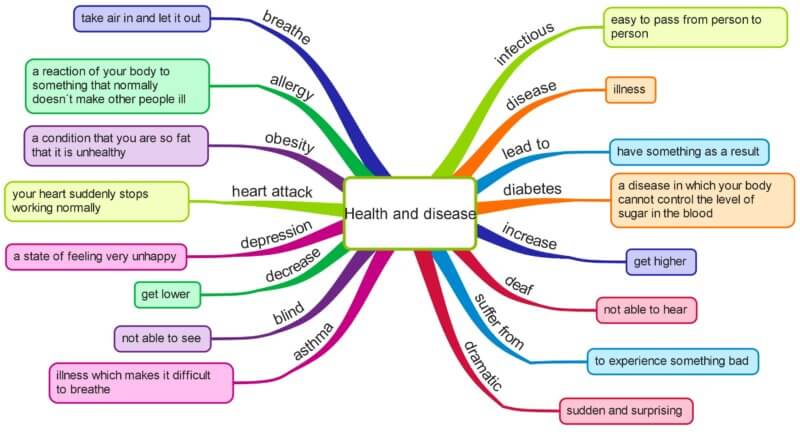
Health and disease – practise the words
In this part, you can practise the words. The first interactive puzzle is the wordsearch. Your task is to find all the words. The remaining letters will give you a hidden message:
Crosswords are another way to practise the vocabulary. There are two crosswords here. Can you solve them both? If you fill in a wrong letter, it will be red. Correct letters are black.
Health and disease – crossword 1
Health and disease – crossword 2
And as there are many sudoku lovers, I have prepared vocabulary sudoku for you, too. Fill in the words breathe, asthma, allergy, increase, obesity, blind, deaf, disease and decrease in such a way that each word is just once in every line, every column and in every small square.
If you would like to learn more words, you can try our post on punctuation.
In this post, you can learn the words used for English punctuation. In this post, you can learn the words full stop, apostrophe, comma, hyphen, colon, dash, semicolon, brackets, question mark, slash, exclamation mark, quotation marks, capital letters, small letters, abbreviation and list.
ADVERT:
[showmyads]
To help you learn the words, there is a revolutionary method called random repeat which helps you learn the words really fast and effectively. Then there are two crosswords, a wordsearch and a sudoku puzzles to help you practise the new words. I hope you will find this post really useful and you will learn the words for English punctuation here.
English Punctuation – learn the words
Try our revolutionary method of learning vocabulary. It is called Random repeat. Click the PLAY button and listen and repeat the words. Once the screen changes its colour, click on the word which you see in the middle. For example, you see ” “, so you have to click on the words Quotation marks. In this way, you will learn the vocabulary really quickly and well.
If you need some examples of the usage, look here:
He/She can’t make it. slash, apostrophe, full stop
Cheers! – exclamation mark
“Mum, I’m at home,” I said. – Quotation marks, comma, apostrophe, comma, full stop.
This eight-year-old girl is very clever. – hyphen, hyphen, full stop
It is just a short walk – and he still took a taxi. – dash, full stop
Infographic
If you prefer graphical presentation of new vocabulary, try the following infographic.
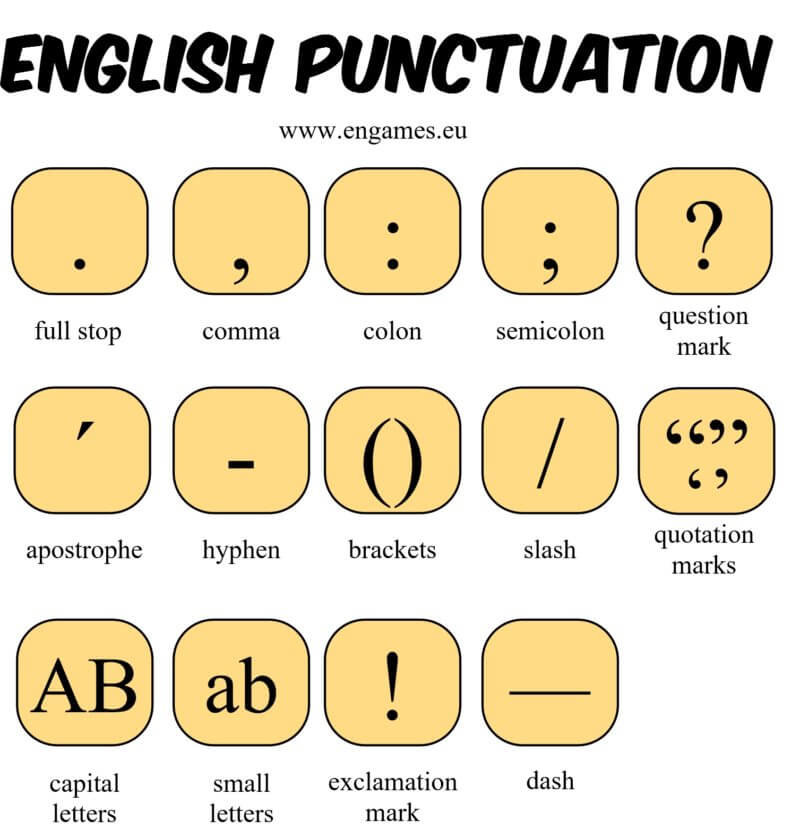
English Punctuation – full image
English Punctuation – puzzles
In this part, you can practise all the new words in puzzles.
First, there are two crosswords:
ADVERT:
[showmyads]
If you prefer a wordsearch try the following puzzle:
Some people love sudoku. In this post, you can print out a sudoku where your task is to fill in the words apostrophe, slash, brackets, colon, full stop, hyphen, semicolon, comma and dash. In each line, column and small square each word can be used just once.
“Why don´t they learn? It is horrible. I have to give him E. Why? What do I do wrong?” I was desperate. “All they had to do was to learn 25 words. And we learnt them at school. And now they know nothing!! What more can I do?!” I wailed.
“Be wise and revise,” Joe spoke.
Graded readers are believed to be extremely useful for learners of English. Many research reports show that learners improve substantially if they read a lot of simplified books. In this post, I would like to share a Graded Reader Comic. It is a Sherlock Holmes story called The Final Curtain. The comic is just six pages long and is suitable for elementary and pre-intermediate learners of English.
ADVERT:
[showmyads]
Sherlock Holmes – The Final Curtain – Graded Reader
I found the following comic in Digital Comic Museum. All the comics published there are in public domain and anyone can download and use them.
I took the original comic, improved the quality of the pictures and simplified the dialogues. You can download and print the graded reader here:
If you prefer video, you can watch the video of the comic here. There is no sound but you can ask your students to read the bubbles aloud.
Graded Readers – research
There are many pieces of research that show that graded readers are very useful for learners of English. To be honest, my personal experience does not support these claims. Recently, I provided my 10-year-old students with two graded readers per week. It was a group of 18 students and it was voluntary to read the books. We went on like this for ten weeks and surprisingly half of the students read all the books provided.
At the end of the period, I gave the students the Level Vocabulary Test by Paul Nation and then my colleague gave the same test to another group of 10-year-olds who study the same textbook. My group knew 10% more words than the control group, but the other group scored better in a grammar test. So, I am not convinced that graded readers are the best thing. But as they do not harm my students, I will keep on using them.
If you are interested in more research on graded readers, you can find it here.
Pictionaries are a powerful method of teaching new vocabulary. In pictionaries, you can see the word and its meaning at the same time, and thus it is easier to remember it. Moreover, good pictionaries are appealing and they attract learners to explore them. Therefore, it is a good idea to include them in your lessons.
“He must be joking!” I thought. I was shocked but I kept quiet. My friend Jane didn´t.
“Why the hell should I throw all my work away?” she asked. We went silent and expected that Jane will be punished.
(more…)Relative clauses are one of the few grammar points I have covered just once. It might have been caused by the fact that I have always considered this grammar easy to understand and explain. Therefore, I never needed several infographics to help me. So it took several years before I created another infographic and a worksheet. I hope you will like them and find them useful.
<!– wp:more –>
ADVERT:
[showmyads]
Relative clauses – infographic
As I mention above, I have always considered relative clauses easy. Of course, there is the difference between the defining and non-defining clauses, but I solved this problem early on in my career and it worked. Now, I would like to share the solution with you.
Have a look at the infographic below:
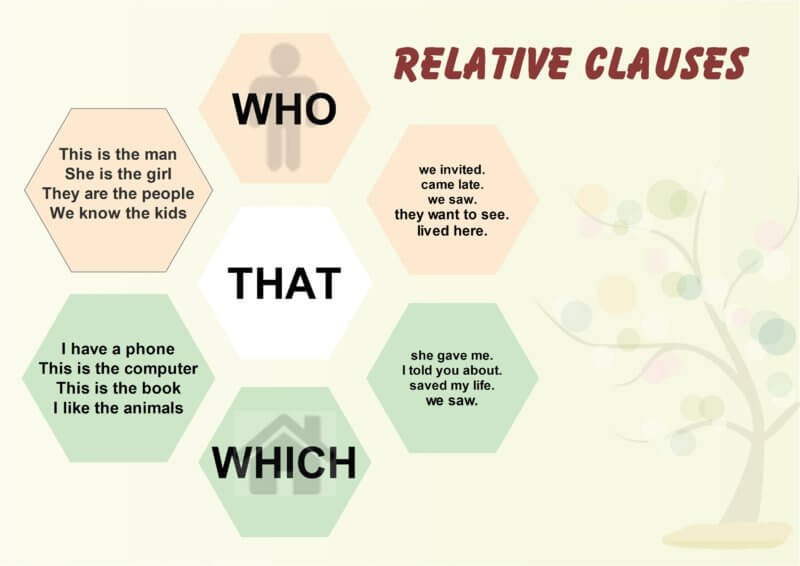
Relative clauses – full picture
As you can see, relative clauses are used to give more details about someone or something. When we give more information about someone, we use the word WHO. When we give more information about something, we use the word WHICH. However, we can use the word THAT instead of WHO or WHICH and the meaning is the same.
The problem is that you cannot use the word THAT in non-defining clauses. Non-defining clauses are the clauses which you can leave out. That was why I always stuck to WHICH and WHO and I never made a mistake. And I advise this to my students too.
Relative clauses – worksheet
Download and print the following worksheet for your students.
There are worksheets A and B in this activity. Hand out the worksheets. You need your students to work in pairs. One student has the worksheet A and the other has the worksheet B.
Students work in pairs and they dictate their text to their partner. The partner listens and writes the sentences as he or she hears them. At the end they check their answers with their partner.
Then, students work on their own and they try to solve the logical puzzle. The solution is down here.
Amanda Mouse Listens to classical music
Jane Snake Programmer
Peter Cat Business trips
Dan Dog Football
In the second exercise, students write the definitions. They can see the correct answers in the brackets.
Then they work in pairs again. They read their definitions and their partner tries to guess the answer. They get one point for each correct answer. The winner is the student with most points.
Good luck and I hope your students will know the grammar very well.
The SVOMPT rule is the most important rule in English. As there are very few declinations in English, the word order rule is the one that keeps the sentences understandable. If you do not apply this rule, your sentences will make no sense.
<!– wp:more –>
Unfortunately, there are very few textbook that teach this grammar explicitly. For example, I teach the textbooks Happy House, Happy Street, Project, Inside Out and Headway and none of them teaches SVOMPT. The rule is taught only implicitly. But I think that this is so important that you need to teach it explicitly. Thus, if your textbook fails to do so, set apart two lessons and teach this rule.
ADVERT:
[showmyads]
To make your work easier, you will find an infographic and a worksheet which you can use in your lessons here.
SVOMPT – explanation
To explain the basic rule you can use the following infographic which I published several years ago. It is nice and comprehensive but for some students it might be a bit overwhelming. (You can find the whole post on SVOMPT here.)
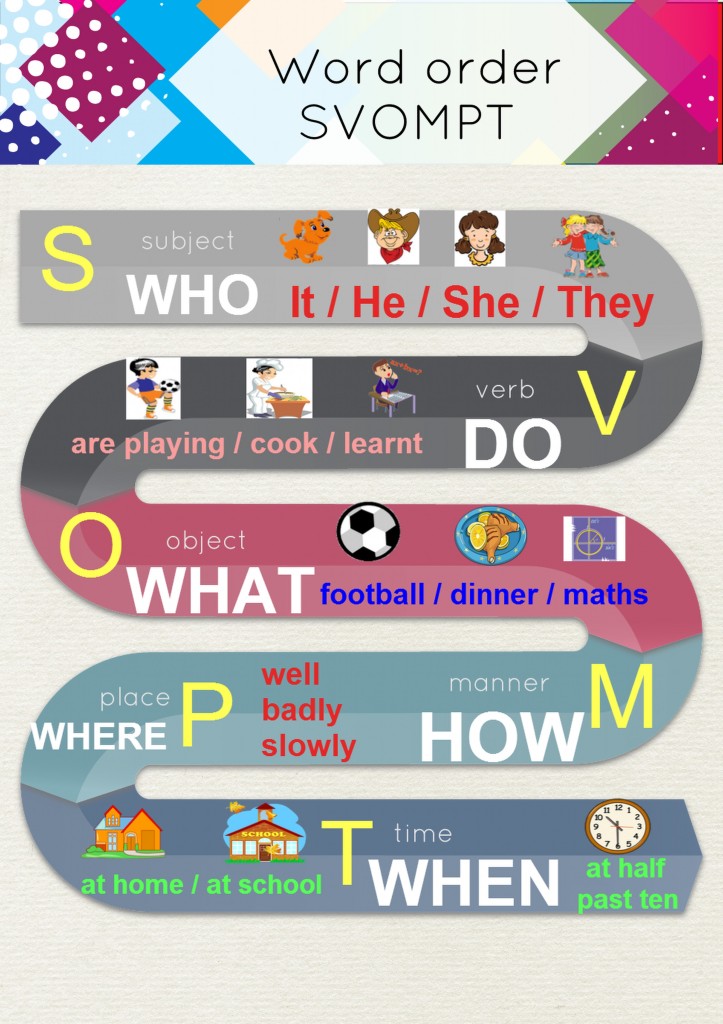
This time I try to make things a bit easier and I created the following infographic.
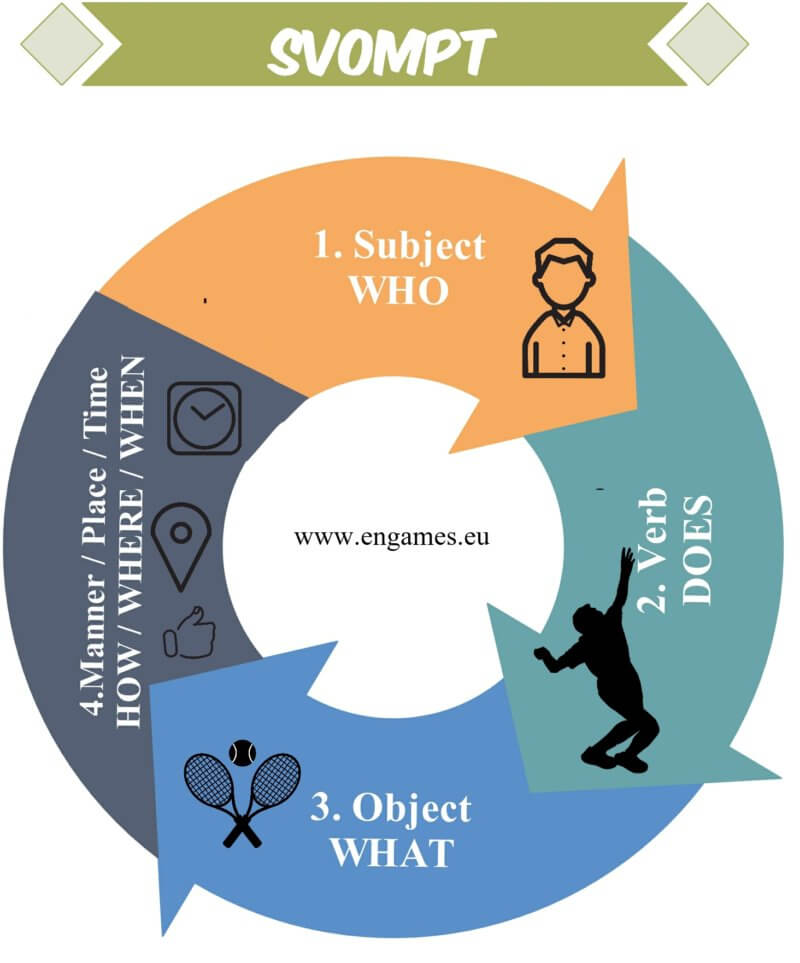
When explaining the rule, emphasize that you cannot leave out the subject. You have to express it and it has to be followed by the action that the subject makes. After the action object follows. Object is the thing that has been somehow affected by the action. Then the adverbs follow.
Students have to remember that each sentence has to contain the SUBJECT and VERB. The other parts might or might not be there.
SVOMPT worksheet
To practise the grammar, here is a worksheet with three exercises.
In the first exercise, students circle the sentences that are correct. You might use the exercise before the explanation.
In the second exercise, students place the word in brackets into the correct position.
In the third exercise, students put the words into the correct order.
In the last exercise, students write sentences about the animals, using the words in the pictures.
Category: English games
At Christmas I got and read a book by Christian Ankowitsch called Warum Einstein niemals Socken trug (Why Einstein Never Wore Socks). The author collects all the pieces of research that show how our physical behaviour influences our thinking. There are many interesting facts that you may find useful in your daily life. But can it help my students?
<!– wp:more –>
ADVERT:
[showmyads]
Yes, it can. If students do some things, they will boost their learning. So I noted down all the ideas to apply at school and I would like to share them here with you.
Better teacher!
How can you be a better teacher? You should study, take a lot of courses and work hard. Sure. But actually, there are a few simple things you can do right now!!!
First, stand straight and tall, and your students will respect you more. They will listen and they will not disturb so much.
Second, keep your classroom tidy and cosy and your students will behave better. Moreover, if you add a pleasant smell that students associate with cleanliness, they will cause fewer problems.
Third, smile and the world smiles with you. Activate the muscles that you use for smiling and you will feel better. And it works for your students too. Make them smile, and they will feel better in your classes. For example, you could ask them to take a pencil into their teeth in such a way that their lips do not touch it. Then they can look around and they will feel better. Curiously, people feel actually better just by activating facial muscles.
Fourth, do you want your students to listen to you? Make them lean forward and spread their arms. People simply take in more if they are in this open position. On the other hand, if they lean back and cross their arms in front of them, you just waste your time. They are closed and the amount of information they receive is small.
Better students!
Do you teach a foreign language? Use a lot of gestures and pronounce clearly. Let your students use gestures. However, be careful to use appropriate gestures. If you use unsuitable moves, your students will be confused.
Most important things shall be placed in the middle of your lessons. If a lesson is 45 minutes long, students remember best all the things that happened between the 15th and 30th minute. Unfortunately, they do not remember much from the beginning of a lesson, so use this part of revision.
To improve your students listening skills, allow them to doodle. Those who doodle listen better.
Let your students chew a chewing gum! Really! But never during a lesson. If they chew five minutes before the lesson starts, their thinking process will improve and they will concentrate more.
Do not allow your students to throw away their notes from a lesson. If they do, their mind will discard the information they learnt, too. In my classes, students often leave their exercise books at home, and they write on a piece of paper. Then they leave the paper behind and their knowledge with it. I will not allow this again! We remember what we write down and carry away.
When you want your students to learn by heart, ask them to hold something in their right hand. A paper tissue is a good solution. They can make a ball out of it. Through this, they will remember the things they learn more easily. And when the students are tested, they should hold something in their left hand. Then the brain retrieves the information more easily.
And last but not least, do not let your students sit at the back of your classroom. Students who sit at the back, get worse scores in their tests. If you seat a bad student in the middle of the classroom or at the front, chances are, that his performance will improve.
A few more facts
Have you ever heard about “clothed cognition”? Do not worry. I haven´t heard about it either. But this says that students behave differently if the clothes they wear are associated with a certain behaviour. For example, a young boy wearing his favourite Superman T-shirt. will get a higher score in his test than normally. Students wearing clothes doctors usually wear, will give their work more attention.
Singers are better at languages than others. Singing activates the same parts of the brain that are necessary for learning a language. And the active brain is the learning brain.
Do you believe that if you ventilate your aggression, you will calm down and behave better the next time? NO! On the contrary. If you do not regulate your behaviour it will be worse the next time.
And it might be a good idea to teach vocabulary in a gym. Students riding a bicycle trainer learnt more words than those sitting in a classroom.
Conclusion
The facts above are in the book Why Einstein Never Wore Socks. There are many more facts in this book, but these are not that easy to apply to a classroom. I can certainly recommend this book.
Speculating about the past is one of the few grammar points I have not covered yet. As I usually teach lower level students, and this grammar is for intermediate students, I haven´t felt it necessary to deal with it. However, now the time has come and I need this explanation for one of my students. I hope you will profit from it too.
<!– wp:more –>
In this post, there are two infographics explaining the grammar and usage of these constructions. Then, there is a worksheet where students can practise the grammar they learn.
ADVERT:
[showmyads]
Modals and perfect infinitive – infographic
I have created two infographics. The first one explains how to form the speculations about the past. You use a modal verb and the perfect infinitive.
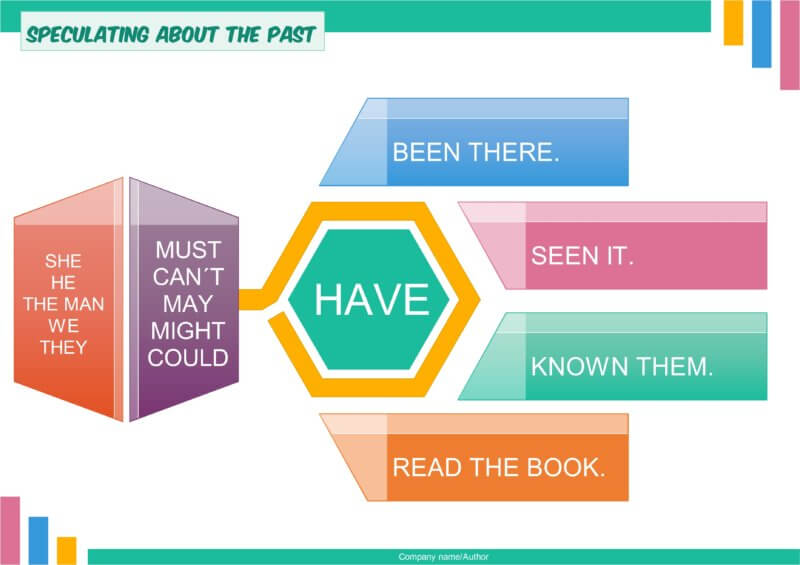
The full picture
Explain, that we need to say who + modal + perfect infinitive to speculate about the past. Then show the second infographic and explain the meaning of the modal verbs with the perfect infinitive.
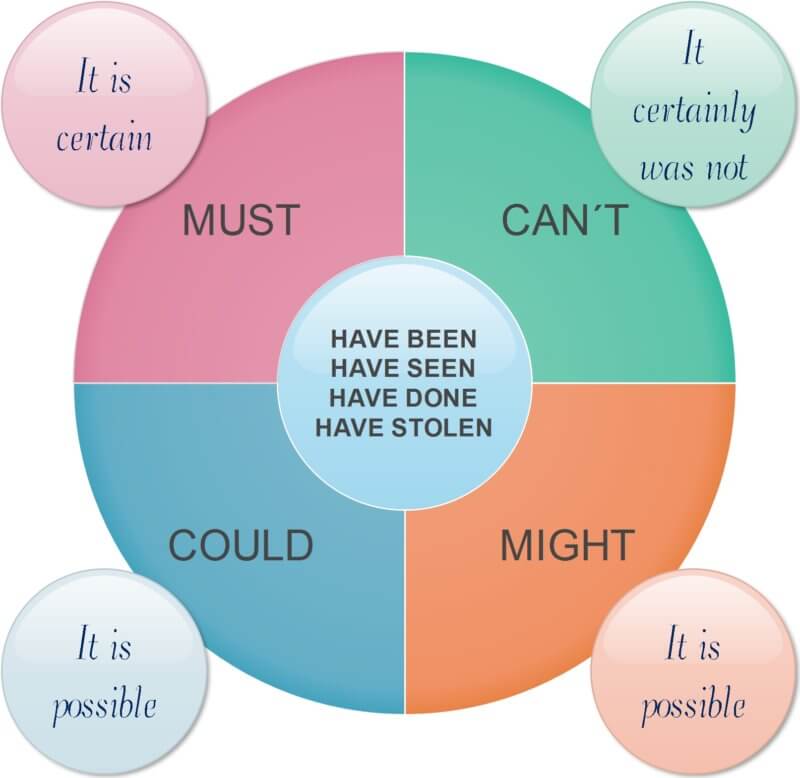
Now that your students know how to form the speculations and what is their meaning, I would ask them to take their exercise books and use the phrases from the infographics and write as many sentences as they can in 5 minutes. In this way, they will practise forming the speculations.
Speculating about the past – worksheet
Download and print the following worksheet.
In the first exercise, students match the sentences with the same meaning. The correct solution is: A3, B2, C6, D5, E4, F1.
In the second exercise, students practise forming the speculations. They have to write the whole sentences this time. The correct solution is: A) Shakespeare might have written this play. B) She must have stolen the money. C) She can´t have driven that car. D) Mark must have spoken to her. E) David can´t have read the book. F) He may have lied.
In the last exercise, students complete the sentences with the correct combination of the modal verbs and perfect infinitives. They use the verbs in the brackets. The correct solution is: 1. must have worked 2. might have forgotten, can´t have got 3. can´t have seen, may have seen, must/might have mistaken 4. can´t have got, must have drunk 5. might have come, can´t have come, might/could have given, could/might have come.
Children love Christmas.
And they love speaking about it.
Here you will find a set of materials to help them speak in English.
(more…)Vocabulary is much more important than grammar. If you know the meaning of the words you can understand a text even without knowing the grammar. If you listen to a recording and you know the vocabulary, you will understand the meaning of the message.
<!– wp:more –>
If you watch a video and understand the words, you can enjoy the film. However, if you know just the grammar you will not understand much. Therefore, we should devote a lot of classroom time to teaching vocabulary.
Unfortunately, most of us don´t spend much time teaching vocabulary. Many teachers of English assign vocabulary as homework and students have to learn the words at home. It is not an entirely bad method. My research shows that 50% of students actually learn the vocabulary on their own. The bad news is that the other half of students don´t do it. They do not learn the vocabulary and after a while they are completely lost. That´s why I think that we should teach vocabulary at school.
ADVERT:
[showmyads]
All the best experts on teaching vocabulary, like Paul Nation or Keith Folse, agree that the best way to teach foreign vocabulary is by using translation. It is the best way for our brain to remember the vocabulary. And in this post, I would like to share with you two methods I have been using to teach vocabulary in my classes. Both of the methods are very effective.
Teaching vocabulary – Remembering Tables
In my article in the magazine English Teaching professional (issue 105), I share with the readers the Remembering Tables method of teaching vocabulary. To do this in your class you need to prepare tables similar to the following:
In the tables on the left, the words are given in both English (in bold letter) and in MT (in this case in Czech). On the right, the tables contain only the Czech words.
At the beginning, read the words in the first table and ask the students to repeat them. Then give the students 20 seconds to study and memorise the words. After this time, they should cover the table and write the words into the table on the right. When they have finished, they uncover the table and check their answers. You go on like this with the rest of the tables, giving the students 30, 40 and 45 seconds respectively.
It is a great classroom activity, but the preparation is a nightmare. To simplify it, I asked a friend to make a word macro which would do all the work for me. And here is the result:
Download the file. Then create a text file which contains 16 lines – use Notepad for this. On each line there is the word in English the plus sign and the word in the students’ mother tongue (e.g. work+pracovat). Save the file. Then open the downloaded macro. It asks you to Select Text File Containing Words. Click SELECT and choose the txt file you have created. And bingo, your tables are finished and you just print them.
Teaching vocabulary – vocabulary books
I teach a group consisting of challenged children. Some of them live in bad conditions, some of them have really low IQ and some have behavioral problems. They are fine, but their test results are appalling. But this week I experienced a great teaching success. These students remembered over 80% of the words I taught them. While previously they scored about 50% on average, this time they were nearly twice as successful.
How did we achieve this? I prepared the following vocabulary books for them.
I printed this as a brochure and then I made small books out of it. I handed them out and I asked the students to complete the tables in their free time during my lessons. In the tables with the free lines, students should copy the English words twice and the Czech translation once.
In the other tables, students have to translate the words. If the word is in English, they translate it into their MT and if the word is in their MT they translate it into English (this is 3 times as frequent as the former translation).
The preparation took some time, but the results were fantastic. Try it out and you will see for yourself.
Category: English games
The difference between the verbs BE and HAVE GOT is essential for learners of English. However, the basic things and concepts are often the most difficult to explain. To be honest, I have to admit that I spent ten years searching for a way to explain this grammar. In the end, I found a solution which I share here. I hope it will make your teaching life easier.
(more…)Category: English games
Months are one of the few lexical sets that students have to learn. In general, lexical sets are difficult to learn and remember. Therefore, we should teach vocabulary in thematic sets. However, there are a few exceptions to this rule. There are some lexical sets which should be taught as such. They are for example numbers, days of the week and months.
<!– wp:more –>
In this post, I am going to offer you several activities to help your students learn all of the months. There is a video, an infographic, a worksheet and a speaking activity.
ADVERT:
[showmyads]
Months – song
Whenever I teach months of the year, I start my lesson with the following song by British Council. It is catchy and it is a great way to introduce the months.
Ask the students to sing along and then introduce the following infographic.
Infographic
Display the following infographic:
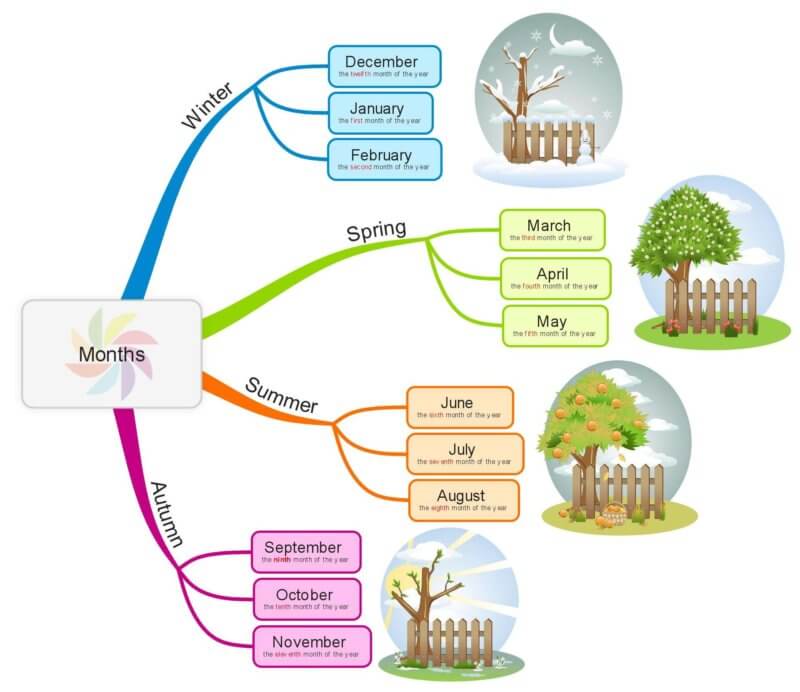
It is a good idea to print the infographic for everyone, so they can take it home. You can print it from the following pdf file.
Months of the year – infographic
Past simple and continuous – song
To practise the vocabulary, download the following worksheet, and print it for everyone. Ask the students to solve the puzzles. It usually takes them about 15 minutes to finish all the tasks. You do not have to check their answers, as it is not possible to finish the tasks while you give wrong answers.
Months of the year – Speaking activity
The following speaking activity is called pair crossword.
- Divide the class into Group A and Group B.
- Explain that you are going to give both groups the same crossword but that group A will have the across words already written in and group B will have the down words already written in. Their task is to write clues for the words written in their crosswords.
- Give a copy of crossword A to each student in Group A and a copy of crossword B to each student in Group B.
- Students work in their groups and write the clues.
- When they have finished writing their clues, the students should work with a partner from the other group. They must not sow their crossword to their partner.
- They sat facing one another and take it in turns to ask their partner for clues to the missing words on their own crossword. They should read out the clues they have written for their partner to guess the words, and write in the missing words on their crosswords from the clues their partner gives them.

